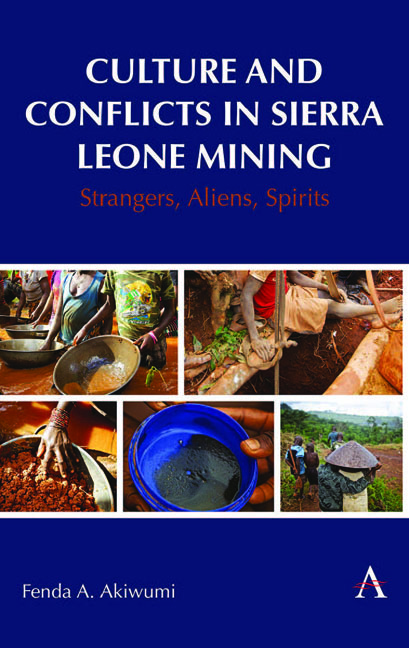Book contents
- Frontmatter
- Dediation
- Contents
- List of Figures and Tables
- Acknowledgements
- Abbreviations
- 1 Introduction: Culture in Commodity Chains
- 2 Sierra Leone’s Global Incorporation Through Mining
- 3 Cultural Difference: Policy and Legislative Dilemmas
- 4 Sacred Places: Local Ontology Meets Global Capital
- 5 Strangers, Environment, and Livelihoods
- 6 Race, Ethnicity, Class, and Gender in Mining
- 7 Between a Rock and a Hard Place
- 8 Conclusion
- References
- Index
5 - Strangers, Environment, and Livelihoods
Published online by Cambridge University Press: 13 April 2024
- Frontmatter
- Dediation
- Contents
- List of Figures and Tables
- Acknowledgements
- Abbreviations
- 1 Introduction: Culture in Commodity Chains
- 2 Sierra Leone’s Global Incorporation Through Mining
- 3 Cultural Difference: Policy and Legislative Dilemmas
- 4 Sacred Places: Local Ontology Meets Global Capital
- 5 Strangers, Environment, and Livelihoods
- 6 Race, Ethnicity, Class, and Gender in Mining
- 7 Between a Rock and a Hard Place
- 8 Conclusion
- References
- Index
Summary
[…] these strangers are clearing the forest on the steep hillsides for farming and thereby denuding the watershed of the Pampana River of vegetation. The communal nature of the land tenure allows them to do this without let or hindrance, and, if anything, the local people are encouraging immigration. (Waldock et al. 1951, 79)
The Sierra Leone mining industry is over 90 years old, so there is a historical legacy of environmental deterioration in places. Mining inherently generates large volumes of waste and impacts the natural environment physically, chemically, and biologically. Unprotected mineral residue stockpiles pollute the environment and are potentially hazardous. Water systems are impacted by damming, discharge of pollutants into watercourses, sedimentation, seepage of contaminants into groundwater, and storm runoff from waste rock and tailings piles. There is more qualitative data to support this and some specific studies have quantified environmental change. Satellite imagery, tailings piles, polluted water bodies, flooding, siltation in streams and rivers, potholes, and waterborne diseases such as bilharzia, onchocerciasis, or “river blindness” and schistosomiasis (Worley Parsons Ltd. 2010).
ESHIA are standard requirements for implementing mining projects in Sierra Leone, today. Environmental laws mandate continuous monitoring for environmental and health impacts in populations around mine sites, but this is not routinely done. The early mining industry and colonial government were primarily concerned about how poor environmental management might impact economic efficiency and supply to the mineral commodity chain. The Mines Department underscored that:
The seriousness of this situation cannot be exaggerated […] because of the destruction, from the point of view of future mining, caused by the partial extraction of the diamonds together with the mixing of the gravel with the overburden. (Govt. of Sierra Leone 1955, 3)
Methods of mineral extraction and processing, data from exploratory surveys, geology, geomorphology, weathering, and erosion can indicate areas where potentially hazardous materials may be present in the environment. The reports of the SLGS, mining company ESHIA reports, research studies, and historical narratives on the mining industry are useful sources of information, also. There are naturally occurring contaminants associated with minerals present in the environment that are released and concentrated by extractive methods.
- Type
- Chapter
- Information
- Culture and Conflicts in Sierra Leone MiningStrangers, Aliens, Spirits, pp. 77 - 96Publisher: Anthem PressPrint publication year: 2024



